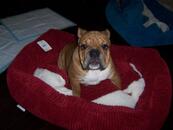AmandaPeterson
New member
- Feb 10, 2014
- 69
- 2
- Country
- USA
- Bulldog(s) Names
- Eleanor Rigby aka. Ellie 4 years and Beaux who is 4months.
I have seen a lot of information about feeding bulldogs fruit and vegetables as treats. I know what not feed them, like grapes, raisins, onions, mushrooms etc. What types of things are you giving your babies? I am currently changing her over from Pro Plan to Fromms grain free. I also give her yogurt, however I stopped this week since she has pneumonia. I appreciate any feedback.
Thanks!!
Thanks!!




